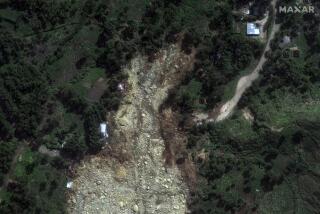Civilian deaths in Sri Lanka may have been vastly underestimated, U.N. panel says
- Share via
Reporting from New Delhi — A U.N. panel has called for an independent investigation of “credible” allegations that tens of thousands of civilians were killed in the final stages of the Sri Lankan civil war two years ago.
The fatality estimate used by the three-member expert panel is significantly higher than the 7,000 civilian deaths cited by the United Nations near the end of the last four months of the bloody conflict, although it’s unlikely that an exact figure will ever be established.
The panel, led by former Indonesian Atty. Gen. Marzuki Darusman, called on U.N. Secretary-General Ban Ki-moon to set up an independent investigation of allegations that both sides committed human rights violations, a move the government of the Indian Ocean island nation has strongly resisted.
Much of the report, to be released this week, was leaked to Sri Lanka’s Island newspaper, which published extracts Saturday. It comes down hard on the government of President Mahinda Rajapaksa, accusing it of deliberately shelling civilians, aid agencies and hospitals.
It also accuses the Liberation Tigers of Tamil Eelam, also known as the Tamil Tigers, of forcibly recruiting ethnic Tamil citizens to fill the rebel group’s declining ranks of fighters.
The report said the group killed other Tamils who tried to flee as the Sri Lankan army surrounded them in a remote area of northeastern Sri Lanka.
Sri Lanka, which has been highly critical of the U.N. and international scrutiny, condemned the 196-page report. Copies were given to Ban and the Sri Lankan government Tuesday.
“The government finds this report fundamentally flawed in many respects,” the External Affairs Ministry said in a statement, adding that it opposed an oversight panel from the start. “Among other deficiencies, the report is based on patently biased material which is presented without any verification.”
The report was hampered by the government’s unwillingness to cooperate. Panel members weren’t allowed to travel to Sri Lankan sites, interview officials or have access to official documents. Instead, the report’s authors relied on photos, video and testimony.
The Sri Lankan government also blocked journalists and international observers from going to the remote northeast during the conflict.
The panel said in its report that the government systematically shelled hospitals on the front lines, including all hospitals in the Vanni region, even though the government was well aware of their location.
“The government also systematically deprived people in the conflict zone of humanitarian aid, in the form of food and medical supplies, particularly surgical supplies, adding to their suffering,” it said. “To this end, it purposely underestimated the number of civilians who remained in the conflict zone.”
The Tigers also used brutal tactics in the course of their unsuccessful quarter-century battle for a Tamil homeland, frequently using civilians as hostages and as a human buffer to separate themselves from the advancing Sri Lankan army. The Tamils finally acknowledged defeat in May 2009.
The rebel group “forced civilians to dig trenches for its own defenses, thereby contributing to blurring the distinction between combatants and civilians and exposing civilians to additional harm,” the report said. “Many civilians were sacrificed on the altar of the [Tamil Tiger] cause and its efforts to preserve its senior leadership.”
More to Read
Sign up for Essential California
The most important California stories and recommendations in your inbox every morning.
You may occasionally receive promotional content from the Los Angeles Times.













